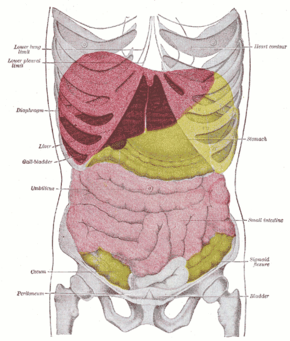Liver span
| Liver span | |
|---|---|
 Anterior view of the position of the liver (red) in the human abdomen. |
The liver span is a measurement performed during physical examination to determine the size of the liver and identify possible hepatomegaly.
It is the distance between the lower border of the liver in the mid-clavicular line obtained by palpation, and the upper border of the liver in the mid-clavicular line detected by percussion (the upper border of the liver lies behind the ribs and can not be palpated). More accurate methods of estimating liver span include ultrasound and cross-sectional imaging (computed tomography or magnetic resonance imaging).[1]
Normal liver span is 6–12 cm (2.4–4.7 in), but varies with age, height, and weight.[2][3][4] Depending on the physician's technique, estimates of the same liver span can vary by 8 cm (3.1 in), on average.[5]
References
- ^ Gosink, BB; Leymaster, CE (January 1981). "Ultrasonic determination of hepatomegaly". Journal of Clinical Ultrasound. 9 (1): 37–44. doi:10.1002/jcu.1870090110. PMID 6792230.
- ^ "Evidence Base - Liver & Ascites Exam - Physical Diagnosis Skills - University of Washington School of Medicine". Retrieved 2009-04-05.
- ^ "Examination of the Liver".
- ^ "Evaluation of the Size, Shape, and Consistency of the Liver". Clinical Methods: The History, Physical, and Laboratory Examinations. Butterworths. 1990. ISBN 9780409900774.
- ^ McGee, Steven. Evidence-Based Physical Diagnosis. p. 434. ISBN 978-0-323392761.